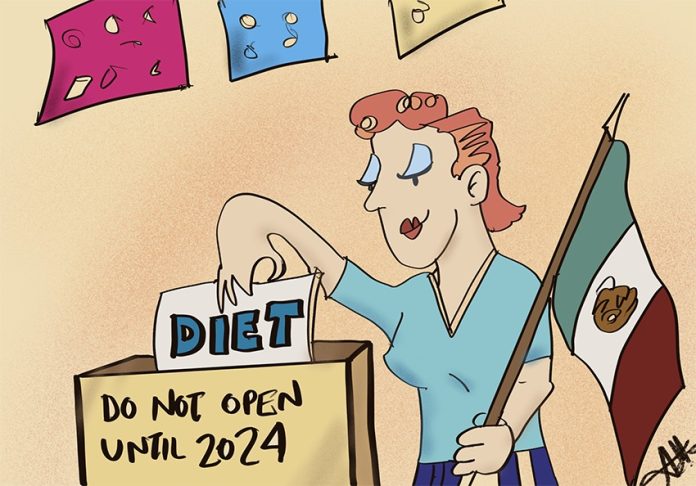Autumn is finally upon us, and with that, what many Mexicans call a veritable marathon of días festivos. It’s a time to have fun, party, and convivir (spend quality time) with your friends and family.
It is not, I repeat, is not a time to go on a diet.
Independence Day
First is Mexico’s Independence Day (September 16), where Mexicans dress up like more traditional versions of themselves and gather in their town squares – the ones who like going out in crowds, anyway – to shout ¡Viva Mexico! (etc.) in a call and answer chant with the highest-level local leader around and revel in their cool Mexican-ness.
A version of this often takes place at elementary schools, with different kids dressing up as various Mexican Independence heroes for a re-enactment. I always find it especially fun to see a kid donning a half-bald wig to interpret Father Hidalgo.
Día de Muertos
After Independence Day, it’s time to prepare for Día de Muertos (Day of the Dead), a several-day celebration dating back to pre-Hispanic times of one’s departed loved ones. While some families’ celebrations might be somewhat somber – especially for those with recently departed loved ones – overall, it’s a lively celebration, filling towns and cities with altars, cultural events, and people with faces painted as colorful calaveritas (skulls).
Posadas
As there’s no Thanksgiving celebration in Mexico, there is no official buffer between Day of the Dead and Christmas, meaning most people inclined to decorate just can’t stop themselves from putting up their Christmas trees in early November. Posadas (which is the word for “inn”) are basically traditional Christmas parties that re-enact a very pregnant Mary and Joseph looking for a place to stay and include piñatas, are carried out all over the country, and pastorelas, a humorous play about shepherds following the star searching for Baby Jesus while being tempted by devils and guided by angels, are performed in schools and churches.
Christmas
Christmas Eve is typically “the big day,” and to my personal morning-person horror, the big meal is served chiefly at midnight. It’s typical to spend it with friends, not just family. Christmas Day is mainly used for sleeping in after the big party. Gifts are primarily for children, and parents tend not to go overboard; some save gifts for Three King’s Day (see below).
New Year’s Eve
New Year’s Eve and New Year’s Day are usually for partying with one’s family and also – you guessed it – eating a big meal at midnight.
Día de Reyes y La Candelaria
January 6th is Three Kings Day (Día de Reyes), where children receive gifts traditionally. (Santa Claus is around because of the US influence, but the Three Kings are the ones who bring you gifts around here, which makes sense, as bringing a kid gifts is what made them famous in the first place.)
It’s also the day to eat rosca de reyes – a round piece of baked bread decorated with candied fruit on top. Inside the rosca are little plastic baby dolls (there’s supposed to be just one, but we almost always find at least 5). If you get a plastic baby in your piece of bread, you are responsible for (drum roll, please!)…giving everyone tamales on February 2, Candelaria Day!
It’s quite a marathon, and again, this bears repeating: don’t even try to start a diet while it’s going on.
You can dance if you want to!
Why do I mention all of these festivities? Because I want to assure you that you’re allowed to participate in them.
A few days ago, the paper’s owner, Travis, showed me a post. It was from a recently-arrived foreigner in Mexico wondering if it would be seen as cultural appropriation to participate in Mexican festivities, such as painting one’s face for Day of the Dead.
Good news! You can participate. You’re encouraged to participate! Mexicans are welcoming, generous, and pretty darn gregarious, too, and they’re not going to scowl at you for braiding your hair this weekend or wearing a bolero tie. They’ll help you paint your face for Day of the Dead and invite you to their posadas.
The dynamics of cultural appropriation here are not the same because the circumstances aren’t the same. We’re in their house. They’re clearly the bosses, the ones who lead the way. Foreigners participating in their traditions are foreigners honoring their traditions. We are not, as we might be seen in the US or Canada, a dominant cultural group virtue-signaling by trying to show off our familiarity with a non-dominant group or trying to take over ownership.
Here, we’re the ones being absorbed, not the other way around. And that’s the beauty of being in a new place: we are changed by the circumstances and environments around us, the way changing light and shadows play to make one color on one wall look a thousand different ways. Letting yourself reflect on what’s happening around you is the most human thing you can do.
So, enjoy. Participate. Learn.
And keep some of your baggier pairs of pants on hand. You might need them.
*These celebrations and their forms can vary according to the locality within the country where you find yourself.
Sarah DeVries is a writer and translator based in Xalapa, Veracruz. She can be reached through her website, sarahedevries.substack.com.
